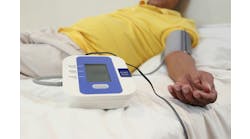To improve medication adherence and reduce the risk of poor outcomes, the University of Maryland Medical Center and the Baltimore City Fire Department partnered to implement a mobile integrated health and community paramedicine program. Olufunke “Olu” Sokan, PharmD, an advanced practice pharmacist, in the university’s School of Pharmacy, recently spoke with Healthcare Innovation about some of the benefits of this program.
Patients with congestive heart failure (CHF) and chronic obstructive pulmonary disease (COPD) are of particular concern because they are at greater risk of poor outcomes if they don’t take their medications as prescribed. These risks can be exacerbated by social disadvantages that negatively impact medication adherence, such as access to transportation, language and literacy barriers, and economic obstacles.
In a pilot project involving patients diagnosed with CHF and/or COPD, EMS providers were tasked with delivering in-home care with the multidisciplinary support of pharmacists, physicians, nurses, and community health workers to patients with complex medical conditions as they transitioned from the hospital to home, explained Sokan, who works in the Center for Innovative Pharmacy Solutions at University of Maryland School of Pharmacy
HCI: Could you talk at first about some of the challenges patients face in Baltimore that this program seeks to address?
Sokan: Our patients are predominantly located in the West Baltimore area. The patient population has high social needs and are very complex patients with multiple comorbidities and low socio-economic status, high poverty, high substance use and psychiatric conditions.
HCI: So the health system wants to help make sure people get their medications and stay on them?
Sokan: Well, the goals with the Mobile Integrated Health Community Paramedicine program were twofold. The first was to reduce hospital readmissions, because with these patients it's like a revolving door. When these readmissions happen within that 30-day window, hospitals get financially penalized. The second was also to reduce overutilization of EMS services. That's why we have the partnership with the Baltimore City Fire Department, which runs the EMS services for Baltimore City.
The goal is to triage those patients so instead of calling 911 and going straight to the hospital, maybe what we need to do is get you to an urgent care or maybe some of our paramedics and nurses will treat patients on scene and prevent that transport, and maybe save a life by reserving those 911 calls for more severe and serious situations.
HCI: Is part of the reason people are heading back to the emergency room or for readmission because they are not picking up meds or staying on their meds?
Sokan: Absolutely. Part of what we did in setting up this program was to do a community assessment to see what these patients actually needed. And it was very apparent that the No. 1 need was medication-related. A lot of our patients are unable to afford their medications. They have low health literacy levels. They may not know how to take the medication. We had to develop a good understanding of why our patients were returning to hospital after discharge. And one of the most common reasons that we found was miscommunication or misunderstanding of the medication regimen, and also a lack of follow-up with their outpatient providers.
HCI: Where did the idea come from to have the EMS teams play this role?
Sokan: This was a partnership between University of Maryland Medical Center and lots of stakeholders, including the Baltimore City Fire Department, as well as the University of Maryland, Baltimore that houses the School of Medicine, the School of Pharmacy and the School of Social Work. All of these schools were also involved in that project. I think that using community paramedics, just came from the fact that they were already involved in the process because when you call 911 EMS responds, so a lot of our patients were familiar with EMS. They even knew some of the medics by name.They had built some level of familiarity and trust, so it just made sense to make them the face of the program, if you will.
HCI: Did the paramedics need to have a line of communication open to pharmacists or nurses so that if they had questions, or the patient had questions, while they were having this conversation, they could get more detail or more information?
Sokan: The community paramedics had specialized training. They had about 60 to 80 hours of direct care inpatient observation, and rounding in the hospital. All of these paramedics also had to get hospital credentialing, because it was important that they had the same EMR access as the providers in the hospital, so that they were not working in silos. So that was some of the ground work that went into making sure that community paramedics could communicate directly with the pharmacists, the social workers, and the doctors on the team, and everyone was on the same page, using the same electronic medical record.
HCI: I understand that to set the baseline, your use DrFirst’s Population Risk Management tool to measure individual prescription fill data for specific populations of patients. Was that so that you could measure the impact of this intervention over time?
Sokan: It wasn't just to measure the impact. A lot of miscommunication about medications happens because of a lack of interoperability, right? The retail pharmacy might have a different electronic record than the hospital uses, and primary care uses something different. So it's a challenge to get the most accurate list of what a patient is taking, especially when the patient is not well educated about what they're supposed to be taking.
So this was a way to track down what the patient was taking before they came into the hospital to make sure that the hospital list was accurate. Once you get that accurate medication list, and when that patient is discharged, we reconcile that on the back end. With the help of DrFirst, we were integrating our inpatient data and the outpatient data to get the most accurate list for the patient.
HCI: Then did you enroll patients in this program and track them over time to measure certain things about their medication adherence or about the impact on their rate of readmission or admission in the hospital?
Sokan: Absolutely. For all of the patients that were enrolled in the program, we provided some identifiers to doctor for us to help us track those patients. We could track what the medication adherence for each patient looked like before they came into the hospital. When the patients come into the hospital, they are enrolled in the program for 30 days. And we also tracked what was their medication adherence after they left the program. So we were not just able to identify potential non-adherence but we were also able to intervene on it before it became a crisis.
HCI: I read that the six-month pilot improved medication adherence by 8 percent to 14 percent in the 60 days after a pharmacist-led intervention. What else were you tracking?
Sokan: There is something called first-fill rates. In a study, I believe in 2010, they looked at about 75,000 patients who were discharged from the hospital, and they found that 30 percent of those patients failed to pick up a first-time medication. For example, if a patient goes into hospital for a stent, one of the medications that they will be started on would be a blood thinner, so that they don't develop a stroke or heart attack. Now, if you send that medication to the patient's pharmacy, and that patient fails to pick it up, that is a readmission waiting to happen, right? So we were tracking the first-fill rates. How many of our patients were picking up their new medications within 30 days of discharge? [Editors Note: Rresearchers found that patients who were enrolled in the MIH-CP after discharge were more likely to fill their prescriptions: Prescription first-fill rates increased by nearly 20 percent for patients with CHF and by 25 percent for patients with COPD in the first 30 days after enrollment.]
HCI: So this was this a pilot project. Is there a way to scale the program up in the community and sustain it?
Sokan: The pilot was actually funded by a state grant. So with mobile integrated health, one of the challenges is funding. Who’s going to pay for this? University of Maryland Medical Center also has its own Transitional Care Program, so we started to look at how we could start to integrate the programs and leverage some of the Transitional Care Program to augment what was already going on. So the hospital picked up some of that sponsorship to continue the program.
Our patients satisfaction survey was also a big plus for the program. The patients received the community paramedics well. They develop relationships with the members of our team, and they found it very helpful. I am a pharmacist and sometimes I still struggle to navigate a very complex health system. These patients have complex conditions — on average three to five medical conditions. That means that they're not only seeing their primary care doctors, but they're seeing multiple specialists. Just organizing those visits and making sure that they're actually attending them was also something that we assisted with. Each patient was assigned a community health worker who assisted the patient with social care needs, and the patients found that helpful.


